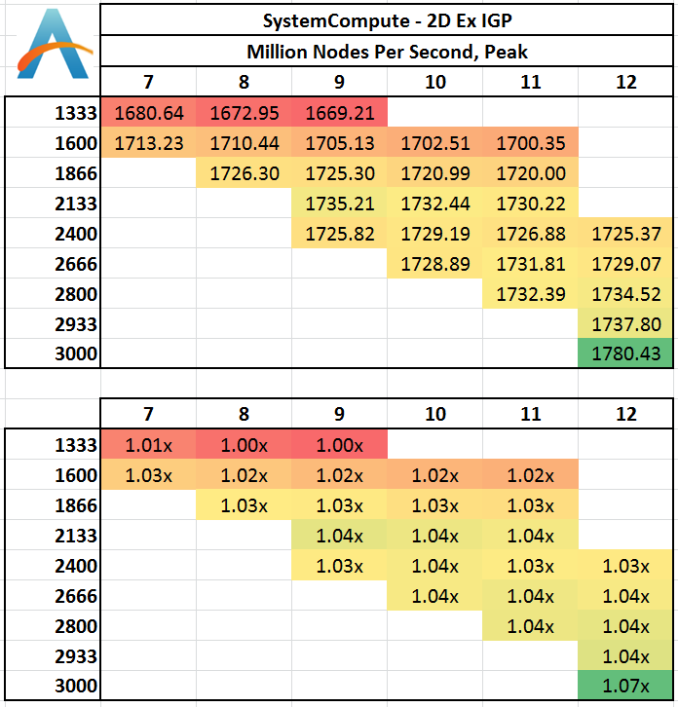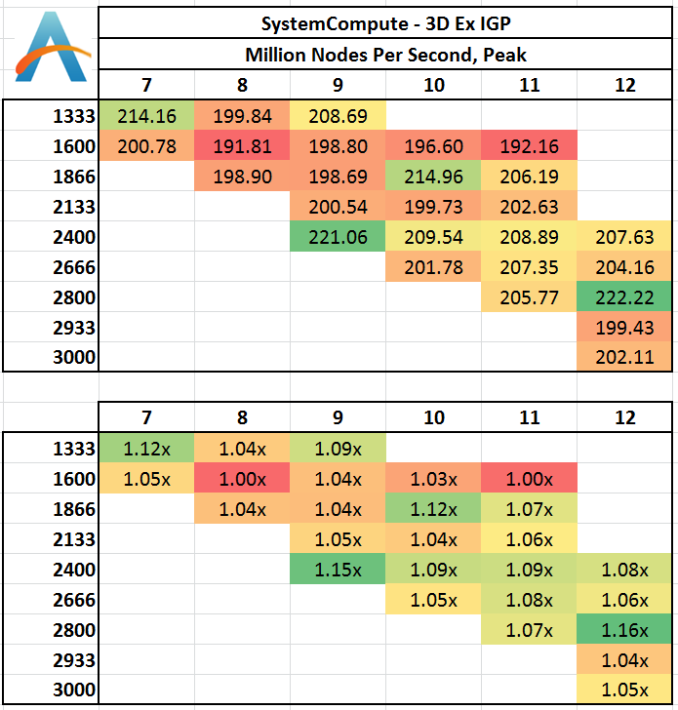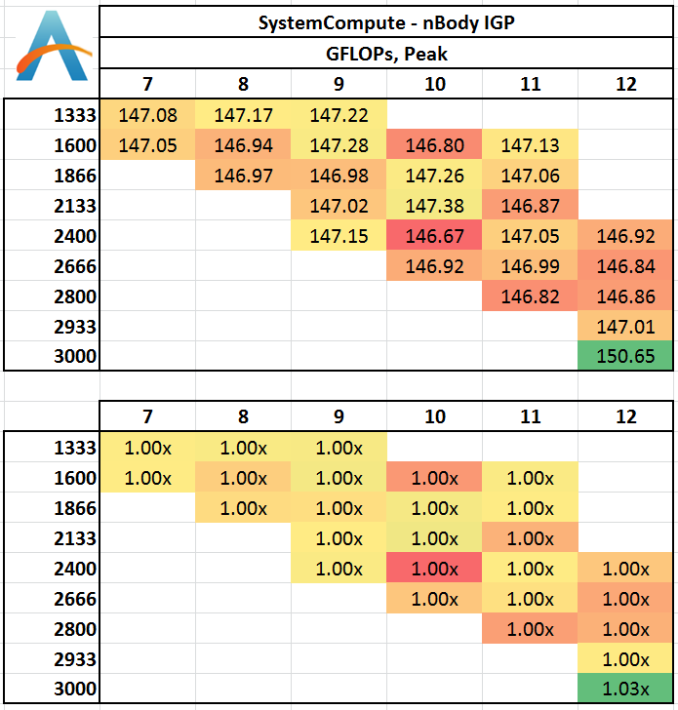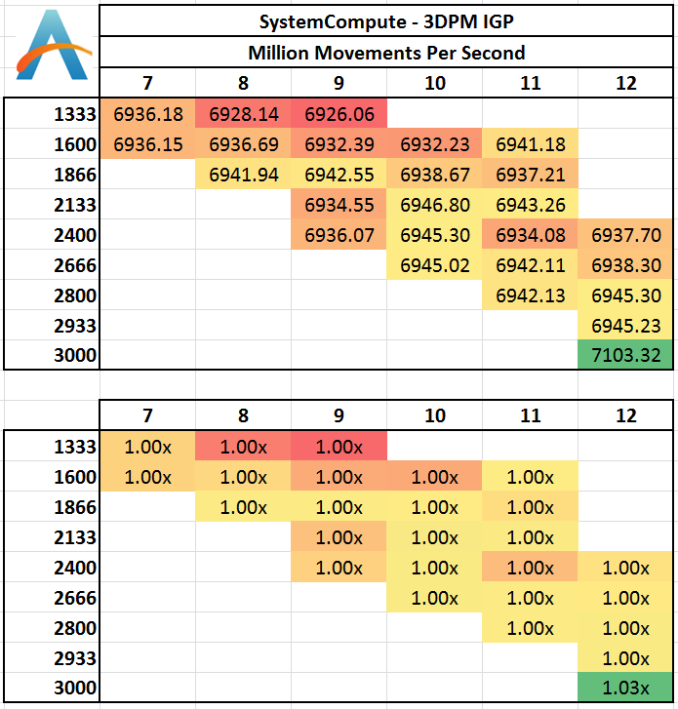Memory Scaling on Haswell CPU, IGP and dGPU: DDR3-1333 to DDR3-3000 Tested with G.Skill
by Ian Cutress on September 26, 2013 4:00 PM ESTOne of the touted benefits of Haswell is the compute capability afforded by the IGP. For anyone using DirectCompute or C++ AMP, the compute units of the HD 4600 can be exploited as easily as any discrete GPU, although efficiency might come into question. Shown in some of the benchmarks below, it is faster for some of our computational software to run on the IGP than the CPU (particularly the highly multithreaded scenarios).
Grid Solvers - Explicit Finite Difference on IGP
As before, we test both 2D and 3D explicit finite difference simulations with 2n nodes in each dimension, using OpenMP as the threading operator in single precision. The grid is isotropic and the boundary conditions are sinks. We iterate through a series of grid sizes, and results are shown in terms of ‘million nodes per second’ where the peak value is given in the results – higher is better.
Two Dimensional:
The results on the IGP are 50% higher than those on the CPU, and it would seem that memory can make a difference as well. As long as 1333 MHz is not chosen, there is at least a 2% gain to be had. Otherwise, the next jump up is at 2666 MHz for another 2%, which might not be cost effective.
Three Dimensional:
The 3D results seem to be a little haphazard, with 1333 C7 and 2400 C9 both performing well. 1600 C11 definitely is out of the running, although anything 2400 MHz or above affords almost a 10%+ benefit.
N-Body Simulation on IGP
As with the CPU compute, we run a simulation of 10240 particles of equal mass - the output for this code is in terms of GFLOPs, and the result recorded was the peak GFLOPs value.
In terms of a workload that calculates FLOPs, the operational workload does not seem to be affected by memory.
3D Particle Movement on IGP
Similar to our CPU Compute algorithm, we calculate the random motion in 3D of free particles involving random number generation and trigonometric functions. For this application we take the fastest true-3D motion algorithm and test a variety of particle densities to find the peak movement speed. Results are given in ‘million particle movements calculated per second’, and a higher number is better.
Despite this result being over 35x the equivalent calculation on a fully multithreaded 4770K CPU (200 vs. 7000), again there seems little difference between memory speeds. 3000 C12 gets a small peak over the rest, similar to the n-Body test.
Matrix Multiplication on IGP
Matrix Multiplication occurs in a number of mathematical models, and is typically designed to avoid memory accesses where possible and optimize for a number of reads and writes depending on the registers available to each thread or batch of dispatched threads. He we have a crude MatMul implementation, and iterate through a variety of matrix sizes to find the peak speed. Results are given in terms of ‘million nodes per second’ and a higher number is better.
Matrix Multiplication on this scale seems to vary little between memory settings, although a shift towards the lower CL timings gives a marginally (though statistically minor) better result.
3D Particle Movement on IGP
Similar to our 3DPM Multithreaded test, except we run the fastest of our six movement algorithms with several million threads, each moving a particle in a random direction for a fixed number of steps. Final results are given in million movements per second, and a higher number is better.
While there is a slight dip using 1333 C9, in general almost all of our memory timing settings perform roughly the same. The peak shown using our memory kit at its XMP rated timings are presumably more due to the adjustments in BCLK which need to be made in order to hit this memory frequency.















89 Comments
View All Comments
Nagorak - Thursday, September 26, 2013 - link
Why did memory prices fluctuate so much since the end of last year and now? The Hynix fire looks to have next to no impact, but the price of memory has nearly doubled since last November/December.aryonoco - Thursday, September 26, 2013 - link
Ian, I do not want to disparage your work, please take this as nothing but constructive criticism. You do amazing work and the wealth of technical expertise is very clear in your articles.But you have a terrible writing style. There are so many sentences in your articles that while technically grammatically correct, are the most awkward ways of saying what you mean. Take a very simple sentence: "In terms of real world usage, on our Haswell platform, there are some recommendations to be made." There are so many ways, much simpler, much cleaner, much shorter to say what you said in that sentence.
I really struggle with your writing style. I know journalism isn't really your day job and you have a lot of important things to attend to, but please, if you care about this side job of yours as a technical writer, being technical is only half the story. Please consider improving your writing style to make it more readable.
Bob Todd - Friday, September 27, 2013 - link
I'd wager most of the readers didn't struggle as mightily as you. If you want to critique another's wordsmithery, you might want to find a classier way to do it. Our first exhibit will be sentence one of paragraph two. Surely you could have strung together a couple of words that got your point across without sounding like an ass?Impulses - Friday, September 27, 2013 - link
Yeah, I'm pretty sure that starting a sentence with a But is something you'd typically avoid...Dustin Sklavos - Friday, September 27, 2013 - link
"You have a terrible writing style."Constructive!
How would you like it if someone came to your place of business and told you "Look, I don't mean to disparage your work, but it makes my cat's hair fall out in clumps."
ingwe - Friday, September 27, 2013 - link
Yep. This definitely wasn't constructive.Ian, I don't see anything wrong with your writing, and I would rather you concentrate on getting articles out than on spending lots of extra time on editing your work.
jaded1592 - Sunday, September 29, 2013 - link
Your first sentence is grammatically incorrect. Stones and glass houses...Sivar - Thursday, September 26, 2013 - link
What a great article. Tons of actual data, and the numerous charts weren't stupidly saved as JPG. I love Anandtech.soccerballtux - Thursday, September 26, 2013 - link
so bandwidth starved apps with predictable data requests (h264 p1) really like it but when the CPU has enough data to crunch (winrar) the lower real-world latency time in seconds is worth having.gandergray - Thursday, September 26, 2013 - link
Ian: Thank you for the excellent article. You provide in depth and thorough analysis. Your article will undoubtedly serve as a frequently referenced guide.